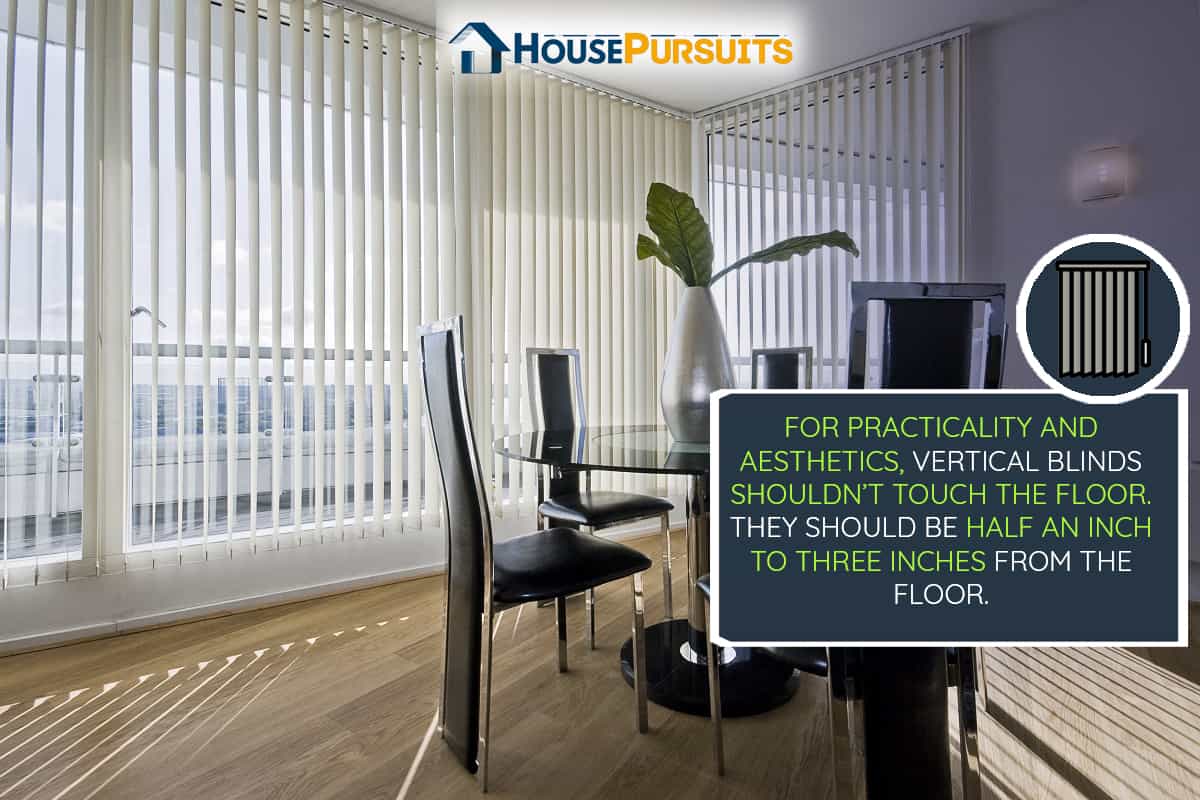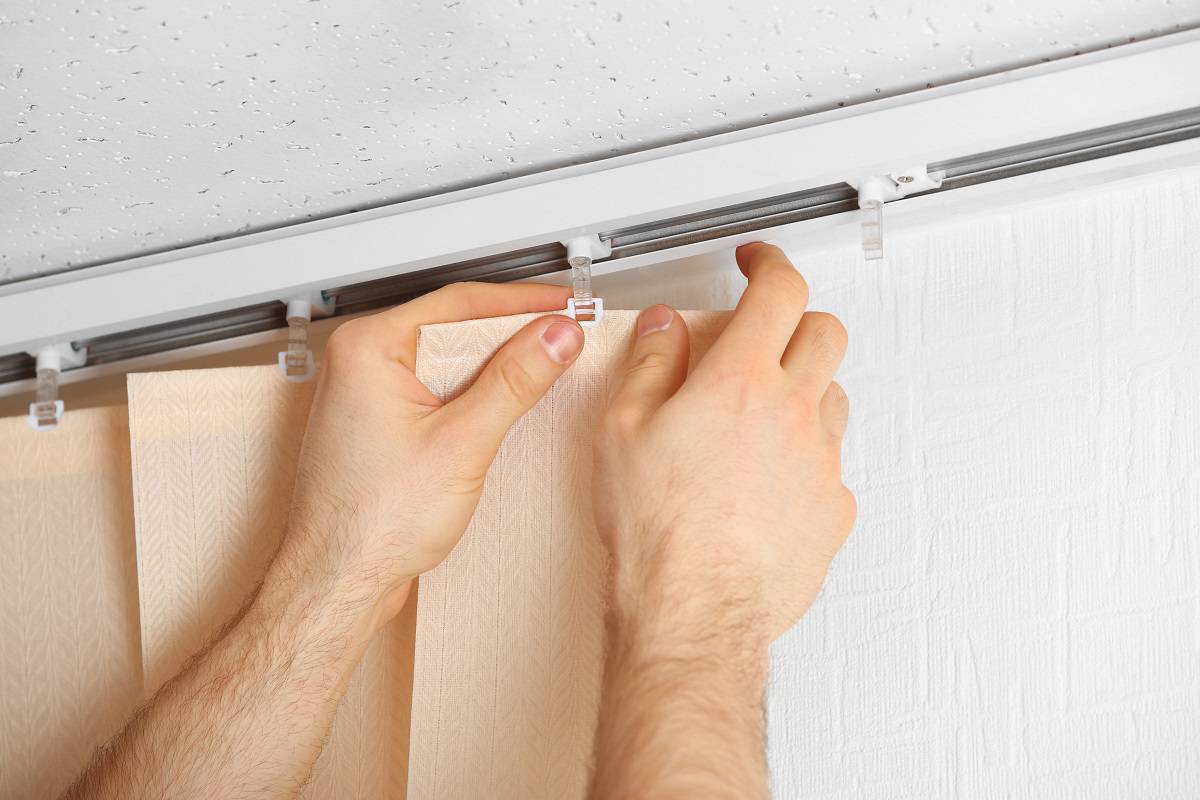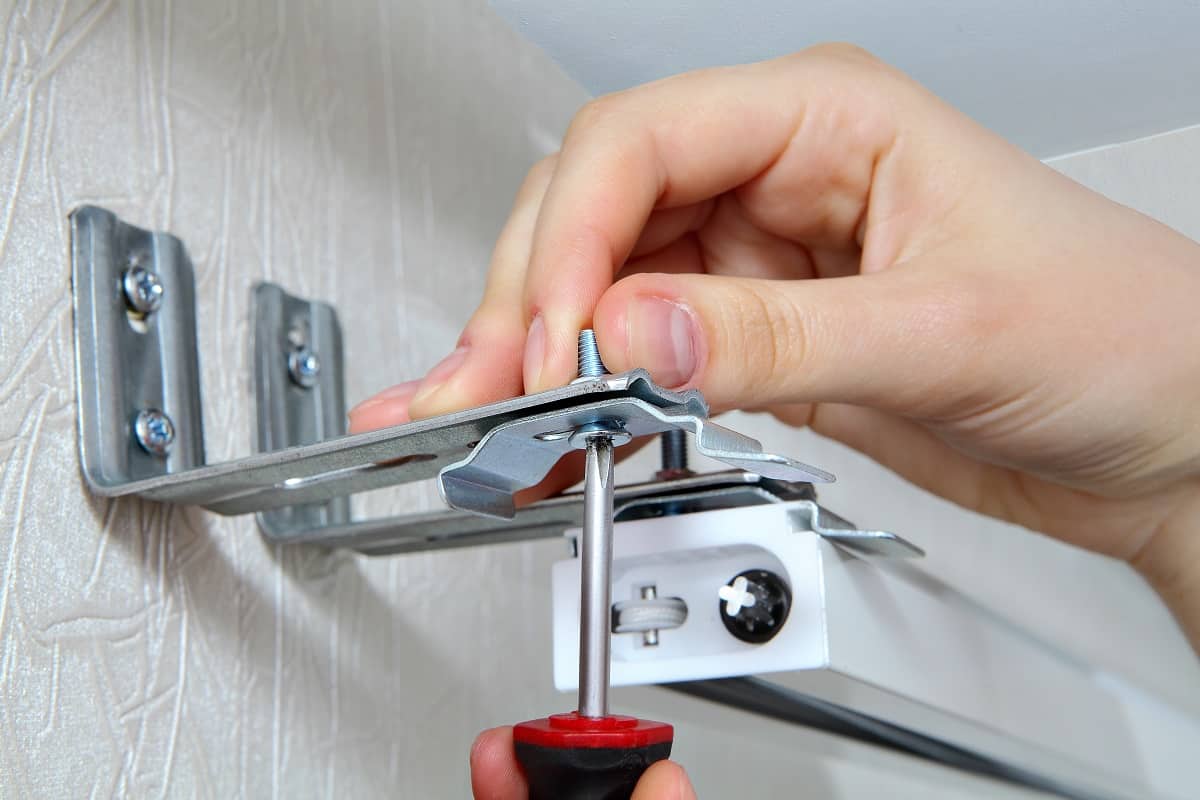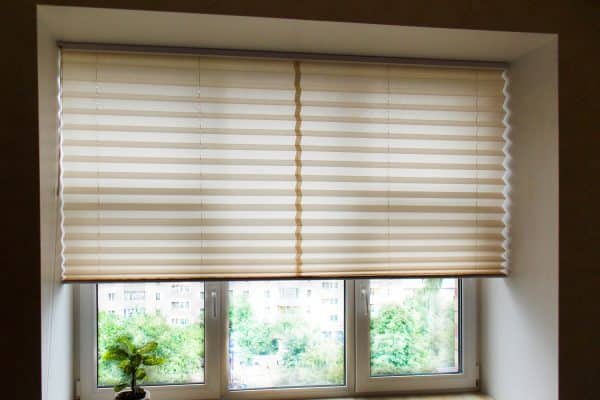Blinds are an economical way of getting the most light in and prying eyes out. Vertical blinds for ceiling-to-floor windows are efficient. However, should they touch the floor? If this question leaves you scratching your head, don't worry; we found answers after extensive research.
For practicality and aesthetics, vertical blinds shouldn't touch the floor. They should be half an inch to three inches from the floor. The molding might be partially or wholly exposed depending on its height. Plus, it makes it easier to clean under the blinds.
The floor clearance seems to vary, but the key is to ensure the blinds don't get stuck on items and lose shape when too long. Continue perusing to find out if there are other alternatives.

How Much Floor Clearance For Vertical Blinds

Different designers seem to differ on how much floor clearance is required for vertical blinds. However, homeowners can use floor molding as a yardstick. If the molding is high, leave a clearance of 1/2 inch to three inches.
Homeowners should assess their floors before settling on the ideal height of the clearance. The size of the vertical blinds will depend on floor evenness, location of the blinds (glass door or expansive window), and movement around them.
Mounting Rules For Vertical Blinds

Moreso, mounting vertical blinds don't start on the floor but only end there. Remember that the primary purpose of blinds is to block light from the windows and glass doors. Therefore, let's start from the top, shall we?
As a beginner or expert homemaker, you should consider the mount type you'd like or the most suitable one for your home if you want vertical blinds. The two mounts available are inside and outside mounts. Both mount types require you to understand their limitations and overall final look.
How Low Should Vertical Blinds Hang?
Vertical blinds need at least three to four inches above the door or window frame. It gives room for the track and covers the door or window from the top without leaving a space. Getting the height right is crucial because you cannot hide extra length in blinds, unlike in curtains.
Do Vertical Blinds Have Standard Sizes?
Vertical blinds have standard sizes, but they are flexible. The dimensions are more like a guideline. Manufacturers and designers can custom-make vertical blinds for your home for a better fit.
How To Install Vertical Blinds On A Glass Door

Before you purchase any vertical blinds, you should decide how you want to mount them. The inside mount means you will take measurements for the header inside the door frame. The blind louvers or vanes and header must be within the door frame. The outside mount needs an overlap, so you take measurements outside the door frame.
Taking Measurements For Inside And Outside Mount
The inside mount requires a clearance of about three inches from the glass door for the header. Although the louvers can be two and a half to three inches, a three-inch clearance is ideal. To get the width, measure from door jamb to door jamb. You'll get the height from the inside of the frame to the bottom.
On the other hand, the outside mount needs you to take the measurements on the wall above the glass door. You can move the brackets up or down to create correct spacing. The overlap to the side can be an inch to two inches to give you more privacy and block out as much light as possible.
Once you have taken the measurements of the glass door, then you can shop for sizes that, if not exact, are very close to your measurements. Or, you can have the blinds custom-made to your precise measurements if there are no available sizes.
Have a look at these standard blinds on Amazon
Installing Vertical Blinds

Now that you have settled for the mount and purchased the blinds you need let's get to the actual installation. Assemble the tools that you need for the job. You'll need a drill, screws, protective eyeglasses, blinds, and accessories for the blinds.
Have a look at protective eyewear on Amazon
The blinds will come with brackets, screws, and a headrail. The number of brackets you need depends on the length of the headrail to stay straight. Once the headrail is mounted, you can now mount the vanes.
Adjust accordingly and do the finishing touches. You might need help mounting the vertical blinds, so invite friends and family to help with this fun DIY project.
Watch the following video for a clear picture of what to do.
Different Types Of Vertical Blinds
Dressing expansive windows and glass doors can be frustrating if you don't make the right choice. Vertical blinds merge style and practicality seamlessly in your home and office. There are several styles, but these are the top five based on customer reviews.
- Sheer Vertical Blinds: These are airy and allow ample light. They are similar to curtains and come in various fabrics and colors.
- Roman Shades: The vanes are more expansive and with heavier material. You could opt for the denser fabric to keep the room dark.
- Gliding Panels: These vertical blinds have a gliding track system. They can cancel noise and keep the light out as they come in heavy and opaque fabrics.
- Wide Vertical Blinds: The vanes in these blinds are more expansive than usual and are in fabrics, wood, or plastic. They are very light but will effectively block out light.
- Vertical Glides: These blinds are like panels and serve as room dividers. The glides are few but expansive in width to cover large windows or glass doors.
Homeowners can choose colors that complement the color scheme in their home decor. These designs allow you to choose the color combinations you like before placing an order for these custom-made vertical blinds.
Types Of Vertical Blinds
Vertical blinds come in PVC, vinyl, wood, aluminum, bamboo, and fabrics. These fabrics used in the vertical blinds are waterproof, pollergen, dimout, or blackout with different colors and densities.
Traditionally, most vertical blinds are wooden or bamboo. They bring a calm and natural feel to your home. Metal or aluminum blinds are the cheapest and most cost-efficient too!
PVC and vinyl have some resemblance. They are often opaque and durable, making them perfect for high-traffic areas such as offices.
Pros And Cons Of Vertical Blinds
Everything has a positive and a negative side to it. However, the advantages of having vertical blinds outweigh the disadvantages.
Benefits
Vertical blinds are:
- Functional and practical solutions for patio doors and large windows.
- Made in various fabrics and colors to cater to many homeowners' tastes.
- Designed to fit most decors, allowing homeowners and designers enough flexibility when designing homes and interior decor.
- Affordable, and it all depends on how much homeowners are ready to spend.
- Versatile and can be opened entirely or partially.
Downsides
Unfortunately, vertical blinds:
- Are very noisy if you pick a cheaper option. The 'clanking' noise the blinds make when blown around by wind can be distracting.
- Break easily if not correctly installed or if they are cheap. Cheap blinds can crack, bend or break due to constant opening and closing.
- Pile up in a cluster blocking the view. If your vertical blinds don't have an overlap, they can gather at the edge of the window and block your view.
Though they aren't suitable for every interior, they have been around for a while.
Are Vertical Blinds Expensive?
The cost of vertical blinds stems from the material used, the length, the blind mechanism installed, and the labor per hour. You might have to cough $40 to $75 per window (terminology used for glass doors) for metal or vinyl vertical blinds. Or, spend $60 to $200 on wooden or fabric blinds.
Additionally, if you want an electrical system, be ready to part with $200 to $1000 per window. These costs vary from state to state. Therefore, get a quotation with several installation options from several professionals to make an informed choice.
To Wrap Up
Vertical blinds should not be dragging on the floor. A clearance of half an inch to three inches is what is recommended. Use the floor molding for guidance.
When choosing vertical blinds, please don't do it blindly. Look for suitable materials, choose the correct mount, make accurate measurements, and see how deep your pockets are!
Look out for more exciting posts!



![Stylish living room interior with comfortable sofa near window, Can Blinds Between Glass Be Repaired [Inc. Broken String, Changing Snap-In, And Uneven Blinds]?](https://housepursuits.com/wp-content/uploads/2022/10/Stylish-living-room-interior-with-comfortable-sofa-near-window-600x400.jpg)

